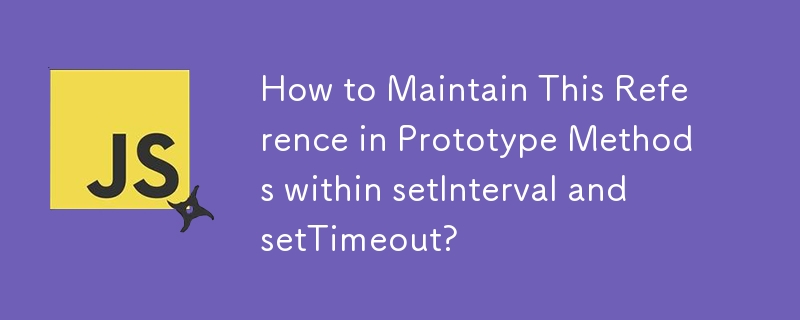如何在 setInterval 和 setTimeout 內的原型方法中維護此參考?
- Patricia Arquette原創
- 2024-10-18 15:05:04286瀏覽

Using this within Prototype Methods in setInterval and setTimeout
When using setInterval or setTimeout, it's essential to maintain a reference to the correct this context inside prototype methods. However, referencing this in these situations can be tricky.
The Problem
For example, consider the following code:
<code class="javascript">function Foo() {}
Foo.prototype = {
bar: function () {
this.baz();
},
baz: function () {
this.draw();
requestAnimFrame(this.baz);
}
};</code>
In this code, an attempt is made to use this to refer to the Foo instance within the prototype method baz. However, this code throws an error because after extracting the method call and passing it to requestAnimFrame, the method loses its reference to this.
The Solution
There are several ways to overcome this issue:
Using an Anonymous Function
One solution is to wrap the method call within an anonymous function:
<code class="javascript">var that = this;
setInterval(function(){
return that.baz();
}, 1000);</code>
In this approach, the this context is saved in the that variable, ensuring correct access to it within the anonymous function's scope.
Using a Fat Arrow Function
If your JavaScript implementation supports fat arrow functions, you can use them to simplify the code:
<code class="javascript">setInterval( () => this.baz(), 1000 );</code>
Fat arrow functions preserve the this context of the surrounding function, eliminating the need for a helper variable.
Using a Binding Function
Finally, you can also use a binding function like Function.prototype.bind to set the this context explicitly:
<code class="javascript">setInterval( this.baz.bind(this), 1000 );</code>
These alternative solutions allow you to maintain the correct this reference within your prototype methods when used with setInterval or setTimeout.
以上是如何在 setInterval 和 setTimeout 內的原型方法中維護此參考?的詳細內容。更多資訊請關注PHP中文網其他相關文章!

